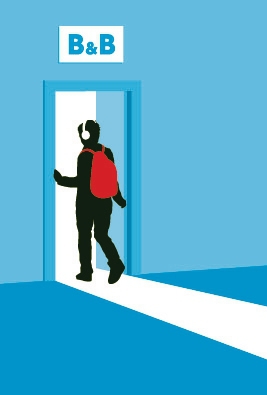From pillar to post
Despite high-profile legal precedents and statutory guidance, homeless 16 and 17-year-olds are being housed inappropriately by many councils. Emily Twinch exposes an ongoing scandal
Child G was just 17 when she was murdered by her boyfriend in May 2012.
She had become homeless three months before her death, but despite still being a child in the eyes of the law it was Wirral Council’s housing – rather than social services – department that dealt with her case. It chose to place her in a multi-occupancy block for young people with low levels of care.
A serious case review into her murder, published in January this year, found that the accommodation she had been placed in was ‘not suitable for her needs’. It suggested the council should have looked at placing her in an appropriately supported environment following a social services assessment of her needs rather than leaving everything to the housing department.
It is impossible to know if the actions outlined in the serious case review would have prevented child G’s violent death – the SCR does not make clear how child G died apart from stating that bloodstained clothing had been found in a tent in some woodland and a member of the public had also found rope ‘as if someone had been tied up’. The SCR does make clear, however, that at the time of her death she had no ‘established relationship with a dependable, trusted adult in whom she could confide and who could offer her reliable advice, guidance and unconditional support’.
It also states she was vulnerable to ‘damaging relationships’ – she had described her boyfriend previously as a ‘very angry person’ to police. The SCR says she was ‘exposed to danger… as her tendency to follow her impulses was ill-restrained by internal qualms or, at that point, by external controls’.
Caroline McKenna, head of safeguarding for children at Wirral Council, gets straight to the point when she talks about the tragedy. ‘She should have been assessed [by a social worker],’ she states, adding that she hopes other councils can ‘learn from the experiences in this case’.
The simple fact of the matter, however, is that councils have already had ample opportunity to learn from experience when it comes to housing 16 and 17-year-olds.
Not a new problem
There have been two high-profile cases pointing out their responsibilities. The first was a landmark ruling in February 2008 involving Hammersmith & Fulham Council, in which Supreme Court judge Baroness Hale of Richmond said children’s services ‘cannot avoid their responsibilities towards this challenging group [16 and 17-year-olds] by passing them over to the local housing authorities’. In that case, she said the council should have provided social care for a 16-year-old girl rather than house her in temporary hotels and hostels.
Next, in May 2009, Baroness Hale chastised Southwark Council for deciding a homeless 17-year-old boy did not qualify for social services accommodation. She told social services to stop ‘passing the buck’, and this is now well-known in the sector as the ‘Southwark ruling’. Ms McKenna admits the council wasn’t ‘applying the Southwark judgement at the time’ of child G’s death.
In April 2010 the government issued statutory guidance which said 16 and 17-year-olds in housing need should be assessed by social services ‘without exception’.
Despite all this, new research by Inside Housing reveals there are still thousands of potential child Gs across England who are not being correctly dealt with when they have a housing need and approach a council for help.
So what precisely did the research find and why are housing officers still stepping in for social services departments on far too many occasions?
Inside Housing sent out freedom of information requests to all councils across England in an attempt to find out. The results speak for themselves.

Over the four financial years from 2009/10 to the end of October last year, 69 per cent (23,806) of 16 and 17-year-olds who approached up to 120 councils that responded were referred straight to housing departments instead of children’s services. This proportion hasn’t changed much over time, with statistics from the seven months between 1 April and 31 October last year revealing that out of a total of 5,789 16 and 17-year-olds who approached 112 councils that provided figures for this period, more than half (3,418 or 59 per cent) were still referred straight to the housing department.
On top of this, just 46 per cent of 16 and 17-year-olds – 15,056 of them, according to the 122 councils who responded to this question – were referred to social services at any stage. Despite the April 2010 guidance saying all should be passed on to children’s services, between April and October last year, just 44 per cent (2,440 out of 5,539) were passed on to social services.
A total of 78 councils gave us an even more detailed breakdown, revealing the number of teenagers they initially assessed in order to find out if they were a child in need and if they required a more in-depth assessment. Out of a total of 24,527 16 and 17-year-olds who approached them over the time period, in just 7,248 (30 per cent) cases, councils complied with their statutory duty.
Local authorities are also still housing young people in bed and breakfast accommodation – something the 2010 guidance says is never suitable ‘even on an emergency accommodation basis’. During the first seven months of 2012, 497 16 and 17-year-olds were dumped in bed and breakfast accommodation – 8 per cent of those housed. This, at least, is a figure that has been improving as 1,188 were housed in bed and breakfasts in 2009/10 – 13 per cent of the total.
Let down
Helen Mathie, head of policy for Homeless Link, says the level of performance exposed by the FOI responses is just not good enough.
‘Young homeless people risk being let down by ineffective joint working between housing and children’s services departments,’ she states. ‘The whole point of the Southwark ruling was to make sure that 16 and 17-year-olds do not fall between these two services.’
Ms Mathie says she believes that the government must put more pressure on councils to meet their legal requirements.
A joint statement issued by the Department for Education and the Communities and Local Government department makes it clear that councils themselves are at fault.
‘It is simply unacceptable for homeless children not to be referred to children’s services for an assessment. We would ask all councils to review their local processes and practices to ensure they are meeting this statutory requirement. The law is clear,’ it states.
Homelessness charity Shelter’s principal solicitor John Gallagher says the findings suggest a number of social services departments and council housing departments ‘don’t have the coordination they should’.
‘Possibly social services set up a system of “gatekeeping” [where people are turned away or directed elsewhere in order to save money] because they want to limit the numbers coming through.’
So, where do the problems lie? Why aren’t all councils managing to refer and assess all the 16 and 17-year-old homeless people who come to them for help?
Departments at war
Toby Graves, head of housing assessment and advice at Hammersmith & Fulham Council, admits there has historically been a ‘difficult relationship’ between housing and social services departments. In some councils, he suggests, the departments are effectively ‘at war with each other’.
‘We operate under different legislative frameworks, the cultures tend to vary and there are often great gaps in understanding,’ he states.
Hammersmith & Fulham launched a joint protocol between social services and housing soon after the Southwark ruling, which Mr Graves says does work well. Two social workers dedicated to homeless 16 and 17-year-olds work in the housing team. Mr Graves says the council had its ‘wake-up call’ before the Southwark ruling because it was the subject of the first High Court ruling and took action.
There is, of course, one simple reason why social services might want to limit numbers – money. If social services departments accept a duty to a young person under the Children Act they must pay for all the wrap-around care that goes with that, including accommodation. Housing departments, on the other hand, can charge rent which can be paid for by housing benefit. ‘If every 16 and 17-year-old ended up a section 20 case [being accommodated by social services under the Children Act] it would blow their [social services] budget out of the water,’ Mr Graves explains.
A case highlighted by the Local Government Ombudsman last summer provides a stark example of what can happen if councils get it wrong.
In her report of August last year, ombudsman Anne Seex said the decisions of Kent and Dover councils in 2009 were ‘inexcusable’. They failed to see 16-year-old ‘J’ as a case for social services, which led to him spending nine months in a tent, suffering physical and mental health problems.
He had been in care but became homeless when he was returned to his mother at the age of 16. He did not want to live with her because of her relationship with an intravenous drug-user.
Jenny Whittle, cabinet member for specialist children’s services at Kent council, says it has ‘overhauled children’s services’ since the case. It has also ‘improved the training and quality of our social workforce and there is a much better understanding of the vulnerabilities and needs of young people in this situation,’ she adds.
Leeds Council’s FOI response revealed it does not pass on all the homeless teenagers who approach it for help to the social services department. For example, of the 808 homeless 16 and 17-year-olds who came to the council in 2011/12, 157 were referred to social services.
Rob McCartney, head of housing support at Leeds Council, explains that in most cases 16 and 17-year-olds will be sent to social services for assessment, but sometimes they might drop out of the process and go home.
Others might be suitable for certain types of accommodation the housing department can offer, such as homes where people can learn to live independently, so there is no need to send them to social services, he says. Should the social services department decide a young person is not a child in need, it will come back to the housing department which will happily accept responsibility, he adds.
‘With the Southwark ruling, neither the housing department nor social services accepted responsibility for the young person [in that case],’ Mr McCartney states. ‘We look at each case and assess it on its individual merits. Providing that young person gets a service, that’s the most important thing. We shouldn’t have a blanket policy. The Southwark judgement tells us to work [social services and housing] together. That’s how we take it.’
The council most synonymous with 16 and 17-year-old case law – Southwark – clearly still has some issues in this area. It did not provide figures showing the proportion of the homeless 16 and 17-year-olds who approached it which were referred directly to housing or passed to social services. The FOI response says this is because the council does not have ‘adequate data’.
A spokesperson for the council explains it was not until 1 October last year – just before Inside Housing’s FOIs were sent out – that a joined-up service between social services and housing was set up and the figures from the two departments correlated. But she does confirm the teenagers would not all be passed on to social services. ‘Not all of the young people who approach our services are necessarily homeless. Enquiries will quickly determine whether or not there is a genuine housing need.’
Collaborative approach
Councils do, however, seem to be more successful in complying with the law where social services and housing work well alongside each other. In November 2010 Birmingham Council set up a ‘youth hub’ in the building of youth homelessness charity St Basils where all its homeless 16 and 17-year-olds are sent. The service is run by the charity and council together and is seen as a ‘one-stop shop’.
Each young person is seen by the housing department and social services, and the charity is on hand to provide a range of services, including providing accommodation where appropriate.
Jim Crawshaw, Birmingham Council’s head of homelessness and pre-tenancy services, points out that the CLG has cited the hub as a prime example of how to comply with the law – the CLG confirms this – and other local authorities have come to visit the project to learn from how they deal with the teenagers.
‘The Southwark judgement was clearly around having joint assessments and working together and that was one of the key drivers for us [in setting up the hub],’ Mr Crawshaw says.
‘The benefit is all three partners are in the same building working together. It’s a holistic approach.
‘Before, young people were bundled around between departments and different buildings. In Birmingham [now] they are all in one place.’ Mr Crawshaw says this has helped bring down the number of teenagers it has housed in bed and breakfast accommodation.
In 2009/10 the council placed 159 16 and 17-year-olds in B&Bs. This figure dropped to 55 in 2011/12 and to just six in the first seven months of 2012/13. Mr Crawshaw explains a small number were still being housed in temporary accommodation because ‘the fact is, in a city of this size, there will always be young people coming to us in emergency situations’.
And it is worth noting, the responses to the FOI requests, compared with similar research Inside Housing carried out two years ago, do show several other local authorities have set up what they call ‘joint protocols’, with social services and housing working alongside each other and deciding on cases together.
Certainly, the extension to the Housing Act in 2002, the two Baroness Hale rulings and the 2010 government guidance, have put added pressure on councils.
Housing departments and social services are now required to work together, even when their relationship has not always been a smooth one in the past.
Where councils can make the relationship between housing and social services work, this seems to be best way to help them achieve their statutory obligations. And ensure better outcomes for homeless 16 and 17-year-olds, such as child G.
Additional reporting by Gene Robertson
Fending for herself
A 16-year-old girl from a London borough was left to fend for herself when her mother moved back to Manchester to be with her new boyfriend. The family were known to social services because the client had suffered sexual abuse from an uncle and her mother’s previous partner – both of whom have been convicted for the offence. Her mother was an alcoholic and the girl wanted to remove herself from her and the family. She approached the housing department five times as she had been left in the house for months, before then contacting a local law centre (which provided us with details about her story). Arrears had accrued and a warrant for the bailiffs had been granted.
The girl had been pushed between departments, and she was very upset about this and felt the local authority did not treat her with respect. The Law Centre solicitor wrote to social services and the housing department reminding them of their joint protocol for homeless 16 and 17-year-olds, which fell on deaf ears. After a letter before action, the client was accepted as a section 20 child under the Children Act 1989; she was accommodated and was able to secure her place in college to study beauty therapy.








